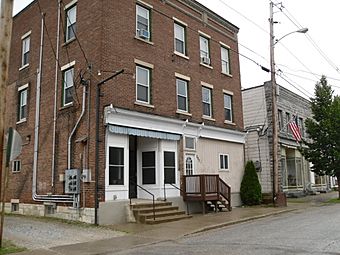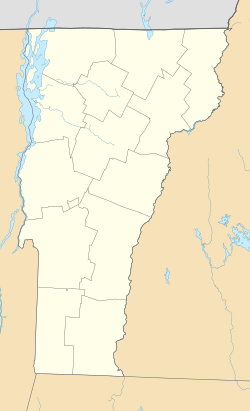Marble Street Historic District facts for kids
Quick facts for kids |
|
|
Marble Street Historic District
|
|
 |
|
| Location | 87-132 Marble St. and 10 Smith Ave., West Rutland, Vermont |
|---|---|
| Area | 3.5 acres (1.4 ha) |
| Built | 1903 |
| Architectural style | Classical Revival, Italianate, Commercial Style |
| NRHP reference No. | 90000338 |
| Added to NRHP | March 1, 1990 |
The Marble Street Historic District is a special area in West Rutland, Vermont. It used to be the main business center of the town. This district is found on Marble Street, between Thrall Avenue and Smith Place. From about 1885 to 1935, this area was super important for the town's money. That's because big marble quarries were the main business back then. The district was later bypassed by new roads. This helped keep many old buildings safe and preserved. It was added to the National Register of Historic Places in 1990.
Contents
Discovering Marble Street's Past
How West Rutland Grew
The area of West Rutland was once part of Rutland. Until the 1830s, it was mostly farmland. People thought it wasn't very good for farming. This was because of swampy land and lots of marble just below the ground.
But then, people realized how valuable the marble was! In 1844, the first marble quarry opened. More quarries started up, especially after the railroad arrived in 1851. This made it easier to move the heavy marble.
Building Marble Street
Marble Street was created in 1853. At first, it was mainly a path for moving marble to and from the quarries. The swampy ground made it hard to build houses or shops there.
Slowly, the swamps were filled in. By the 1880s, many businesses began to open on Marble Street. This made the area a busy place.
A New Start After the Fire
In 1903, a big fire destroyed many of the commercial buildings. But this led to a new wave of construction. Many new buildings were put up, making the street look fresh.
The area started to slow down in the 1930s. This happened when many of the marble quarries closed. Also, a new road, United States Route 4, was built. It went around Marble Street.
Why Marble Street is Special Today
The new road helped save Marble Street. It stopped the area from being changed too much. Because of this, we can still see many well-preserved buildings. These buildings were built between the 1880s and the 1930s. They show us what the town looked like long ago.
Exploring the Historic District Buildings
What You'll See on Marble Street
The historic district is mostly one block of Marble Street. It runs from Smith Place to Thrall Avenue. It also includes a bit of land past these streets. One house on Smith Place is also part of the district.
In total, there are ten business buildings and four houses. The biggest business building is the Shirt Waist Factory. It has three stories and is made of brick. Most other buildings are shorter, about two stories high.
Architectural Styles and Features
The buildings on Marble Street look quite similar. They are set back from the road in the same way. This is partly because when they rebuilt after the 1903 fire, they kept the old building lines.
Many buildings show an Italianate style. This style was popular a bit earlier than when these buildings were built. You might see fancy brackets and deep eaves (the part of the roof that hangs over the walls).



